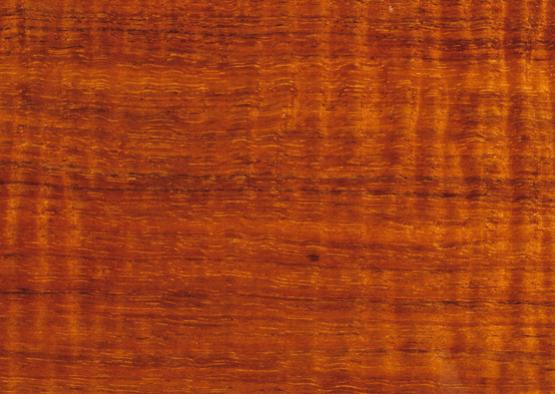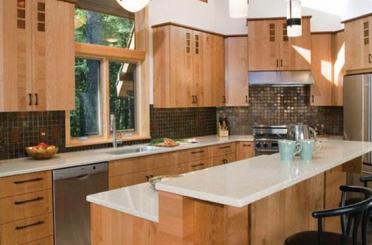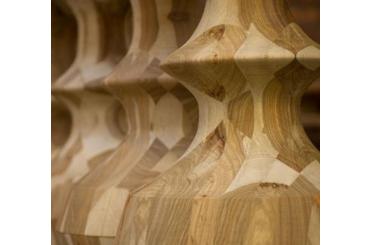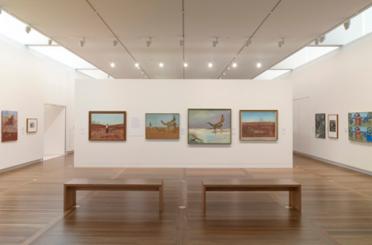Blackwood is a medium-sized Australian hardwood that yields an attractive timber often used for decorative veneers, furniture and paneling.
Australian Blackwood, Paluma Blackwood, Black Wattle
Acacia melanoxylon

Blackwood is a medium-sized Australian hardwood that grows in South Australia and the eastern states. In the wetter areas of Tasmania it is grown in large volumes for commercial use.
It is definitely an ‘appearance timber’, with a heartwood that is a rich golden brown. This is sometimes complimented by reddish streaks or a narrow band of darker colour, indicative of the growth rings. The sapwood is much paler in appearance. Blackwood has a medium and even texture. Its grain can either be straight or have a wavy, fiddleback pattern, which is valued for furniture and veneers.
Blackwood is easy to work and nails and glues well. A smooth, polished finish can be achieved, making blackwood ideal for furniture. It is also good for steam bending. If the grain is wavy then this may require the planer angle to be adjusted. It is important that safety precautions are taken when sanding blackwood, as the dust can cause irritations.
While blackwood is a durable, interior-use timber it has a low in-ground durability and is not ideal for external applications.
It is readily available, especially in Tasmania, but may only be available in relatively small sizes.
Shrinkage
| Very Low | Low | Medium | High | Very High | |
|---|---|---|---|---|---|

|

|
||||
Tangential : |
4.20%
|
||||
Radial : |
1.60%
|
||||
Unit Movement Tangential: |
0.27%
|
||||
Unit Movement Radial: |
0.16%
|
Strength Group

Very High |
High |
Reasonably High |
Medium High |
Medium |
Reasonably Low |
Low |
Very Low |
||
Unseasoned: |
S1 |
S2 |
S3 |
S4 |
S5 |
S6 |
S7 |
S8 |
|
|---|---|---|---|---|---|---|---|---|---|
 |
|||||||||
Seasoned: |
SD1 |
SD2 |
SD3 |
SD4 |
SD5 |
SD6 |
SD7 |
SD8 |
|
 |
Stress Grade

| Structural No. 1 |
Structural No. 2 |
Structural No. 3 |
Structural No. 4 |
Structural No. 5 |
|
Unseasoned: |
F14 |
F11 |
F8 |
F7 |
F5 |
Seasoned: |
F22 |
F17 |
F14 |
F11 |
F8 |
Density per Standard

Seasoned: |
650kg/m3
|
|---|---|
Unseasoned: |
1050kg/m3
|
Joint Group

Very High |
High |
Reasonably High |
Medium |
Low |
Very Low |
|
Unseasoned: |
J1 |
J2 |
J3 |
J4 |
J5 |
J6 |
|---|---|---|---|---|---|---|
 |
||||||
Seasoned: |
JD1 |
JD2 |
JD3 |
JD4 |
JD5 |
JD6 |
 |
Colour

| White, yellow, pale straw to light brown | Pink to pink brown | Light to dark red | Brown, chocolate, mottled or streaky | |
 |
||||
Mechanical Properties
Modulus of Rupture - Unseasoned: |
72
|
|---|---|
Modulus of Rupture - Seasoned: |
110
|
Modulus of Elasticity - Unseasoned: |
12
|
Modulus of Elasticity - Seasoned: |
14
|
Maximum Crushing Strength - Unseasoned:  |
34
|
Maximum Crushing Strength - Seasoned: |
58
|
Impact - Unseasoned: |
12
|
Impact - Seasoned: |
15
|
Toughness - Unseasoned: |
Medium - 15 - 24 Nm
|
Toughness - Seasoned: |
Medium - 15 - 24 Nm
|
Hardness - Unseasoned: |
4.2
|
Hardness - Seasoned: |
4.9
|
Durability
| Low | Moderate | Reasonably High | High | |
| (0 - 5 yrs) | (5 - 15 yrs) | (15 - 25 yrs) | (more than 25 yrs) | |
In-Ground: |
 |
|||
| (0 - 7 yrs) | (7 - 15 yrs) | (15 - 40 yrs) | (More than 40 yrs) | |
Above ground: |
 |
|||
| (0 - 20 yrs, usually < 5) | (21 - 40 yrs) | (41 - 64 yrs) | (More than 60 yrs) | |
Marine Borer Resistance: |
 |
Lyctid Borer Susceptibility: |
Susceptible |
|---|---|
Lyctid Borer Susceptibility - Other: |
|
Termite Resistance: |
Fire Properties
| 0 | 1 | 2 | 3 | 4 | 5 | 6 | 7 | 8 | 9 | 10 | 11 | 12 | 13 | 14 | 15 | 16 | 17 | 18 | 19 | 20 | |
EFH Ignitibility: |
| 0 | 1 | 2 | 3 | 4 | 5 | 6 | 7 | 8 | 9 | 10 | |
EFH Spread-of-Flame Index: |
|||||||||||
EFH Smoke-Developed Index: |
Critical Radiance Flux - Lower: |
>2.2 and <4.5 |
|---|---|
Critical Radiance Flux - Higher: |
≥4.5 |
Smoke Development Rate: |
<750
|
| 1 - non-combustible | 2 - reasonably non-combustible | 3 - slightly combustible | 4 - combustible | |
Fire Properties Group |
Average Specific Extinction Area: |
<250
|
|---|---|
Bushfire Resistance: |
BAL 12.5 and 19 – Door and window joinery only
|
Blackwood timber is sought after for its impressive appearance and finish qualities. The heartwood is a rich, golden brown, sometimes complimented by reddish streaks or a narrow band of darker colour, indicative of the growth rings. The sapwood can be up to 50mm wide and is much paler in appearance. Even-textured, blackwood grain can either be straight or have a wavy, fiddleback pattern, which is valued for furniture and veneers.
Blackwood is commonly used for interior-based applications such as decorative veneers, panelling, furniture, joinery and flooring. It is an attractive and durable interior-based timber but has low in-ground durability so it is not ideal for external applications.
Other applications include carving, turning, flooring, boat building and gunstocks.
Blackwood has a good overall workability. It is easy to nail and glues well. A smooth, polished finish can be achieved, making blackwood ideal for furniture. It is also good for steam bending.
If the grain is wavy then this may require the planer angle to be adjusted.
It is important that safety precautions are taken when sanding blackwood, as the wood dust can cause irritations.

Joinery

Mouldings

Flooring
Allied Forest Products
Australian Timber

Briggs Veneers Pty Ltd
Britton Timbers

Cameron's H Hardware

Creative Timber World

Floors of Distinction

Forest Strategy Pty Ltd
Hammer Roo

HYDROWOOD

Lifestyle Furniture

Ludbrook’s Joinery
M1 Timber Works Pty Ltd

Matilda Veneer

Ridgewood Timber Pty Ltd

The Window Man

Three(3)DM Pty Ltd






